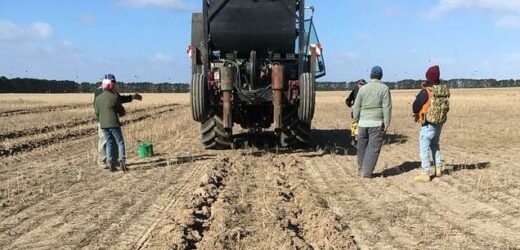Would YOU try it? Study confirms cabbages grown in compost made from human POO are safe to eat
- Study shows cabbages grown in compost made from human poo are safe to eat
- Suggests it could therefore be used as a fertiliser for crops on farms worldwide
- Taking this action could help tackle climate crisis, biodiversity loss and pollution
- The research tested crop yield from faecal compost and nitrified urine fertilisers
In the 2015 blockbuster film The Martian, Matt Damon manages to survive on Mars after using his own faeces as fertiliser to grow potatoes.
Such a thing may seem far-fetched – or even unnecessary here on Earth – but a new study has found that cabbages grown in compost made from human poo are safe to eat.
The discovery could be a game-changer, because although it may seem like existing fertilisers are just fine, to tackle the climate crisis, biodiversity loss and pollution, humanity will need to move to a more recyclable existence.
This is why scientists are questioning the merit of having the nutrient-rich fertiliser that is human drifting into our oceans and landfills, when it could easily be put back into soils.
Breakthrough: A new study has found that cabbages grown in compost made from human poo are safe to eat. It was carried out by experts at the University of Hohenheim, Stuttgart. It follows past research by Federation University Australia which found that biosolids produced from human wastewater can increase wheat yields between 55 and 65 per cent (pictured)
Composting rather than flushing it would bring down water use, while adding it to land also reduces the need for synthetic fertilisers, which can wash away from fields into rivers and lakes and requires fossil fuels to make.
One way of making it, known as the Haber-Bosch process, leads to around 1.8 per cent of global CO2 emissions.
So human fertiliser certainly has its benefits, as long as there is no risk that harmful microbes or traces from pharmaceuticals could end up in crops, which the University of Hohenheim, Stuttgart, has now confirmed is not the case.
HOW HUMAN WASTE IS A NUTRIENT-RICH FERTILISER
Most nutrients needed for plant growth occur in human urine and faeces, with nitrogen and potassium in urine – along with trace amounts of metals such as boron, zinc, and iron – and phosphorus, calcium, magnesium and organic carbon in poo.
So human fertiliser certainly has its benefits, as long as there is no risk that harmful microbes or traces from pharmaceuticals could end up in crops, which has now been confirmed is not the case according to research by the University of Hohenheim, Stuttgart.
Study author Franziska Häfner said: ‘Here we show that products derived from recycling human urine and faeces are viable and safe nitrogen fertilisers for cabbage cultivation.
‘The fertilisers from nitrified human urine gave similar yields as a conventional fertiliser product, and did not show any risk regarding transmission of pathogens or pharmaceuticals.
‘The combined application of nitrified urine fertilisers and faecal compost led to slightly lower crop yields, but may increase soil carbon content in the long term, promoting climate-resilient food production.’
Most nutrients needed for plant growth occur in human urine and faeces, with nitrogen and potassium in urine – along with trace amounts of metals such as boron, zinc, and iron – and phosphorus, calcium, magnesium and organic carbon in poo.
For their study, PhD student Häfner and her colleagues compared a crop yield of white cabbage grown between June and October 2019 at the Leibniz Institute of Vegetable and Ornamental Crops.
The soil was enriched with four recycled fertilisers, applied gradually over the growing season, with commercially available organic vinasse used as the benchmark to compare the human urine and faeces to.
Also tested were two so-called ‘nitrified urine fertilisers’ (NUFs), modern products synthetised from human urine that has been collected separately from faeces, in which nitrogen-bearing compounds are converted by microbes into valuable ammonium and nitrate.
Finally, faecal compost recycled from dry toilets was used, both with and without NUFs mixed in.
The marketable yield, defined as the parts of the cabbages that can be sold, ranged from 35 to 72 metric tons per hectare.
It was highest for plots fertilised by the NUFs and vinasse, and lowest for those fertilised by faecal compost alone.
Somewhere in the middle was the faecal compost combined with NUFs.
Human fertiliser certainly has its benefits, as long as there is no risk that harmful microbes or traces from pharmaceuticals could end up in crops, which has now been confirmed is not the case according to research by the University of Hohenheim, Stuttgart
In the 2015 blockbuster film The Martian, Matt Damon manages to survive on Mars after using his own faeces as fertiliser to grow potatoes (pictured)
The researchers say their results suggest that soils fertilised with NUFs are as productive as those supplied with the widely-used commercial vinasse.
In the study they also screened for the presence of 310 chemicals in the faecal compost, from pharmaceuticals to rubber additives, flame retardants, UV filters, corrosion inhibitors, and insect repellants.
Just 6.5 per cent of these were present above the limit of detection in the compost, albeit at low concentrations, including 11 pharmaceuticals.
Among the latter, only the painkiller ibuprofen and the anticonvulsant and mood-stabilizing drug carbamazepine were detectable in the edible parts of the cabbages, at low concentrations.
It means that that more than half a million cabbage heads would need to be eaten to accumulate a dose equivalent to one carbamazepine pill, the researchers said.
‘In general, the risk for human health of pharmaceutical compounds entering the food system by means of faecal compost use, seems low,’ they concluded in their study.
Lead author Dr Ariane Krause, a scientist at the Leibniz Institute of Vegetable and Ornamental Crops in Großbeeren in Germany, said: ‘Our study results demonstrate that nitrified urine fertilisers such as Aurin and CROP have a huge potential as fertiliser in agriculture. They argue for a greater use of these recycled products in the future.’
She added: ‘If correctly prepared and quality-controlled, up to 25 per cent of conventional synthetic mineral fertilisers in Germany could be replaced by recycling fertilisers from human urine and faeces.
‘Combined with an agricultural transition involving the reduction of livestock farming and plant cultivation for fodder, even less synthetic fertiliser would be necessary, resulting for example in lower consumption of fossil natural gas.’
The research has been published in the journal Frontiers.
HOW DOES EATING MEAT AND DAIRY PRODUCTS HURT THE ENVIRONMENT?
Eating meat, eggs and dairy products hurts the environment in a number of different ways.
Cows, pigs and other farm animals release huge amounts of methane into the atmosphere. While there is less methane in the atmosphere than other greenhouse gases, it is around 25 times more effective than carbon dioxide at trapping heat.
Raising livestock also means converting forests into agricultural land, meaning CO2-absorbing trees are being cut down, further adding to climate change. More trees are cut down to convert land for crop growing, as around a third of all grain produced in the world is used to feed animals raised for human consumption.
Factory farms and crop growing also requires massive amounts of water, with 542 litres of water being used to produce just a single chicken breast.
As well as this, the nitrogen-based fertiliser used on crops adds to nitrous oxide emissions. Nitrous oxide is around 300 times more effective at trapping heat in the atmosphere. These fertilisers can also end up in rivers, further adding to pollution.
Overall, studies have shown that going vegetarian can reduce your carbon emissions from food by half. Going vegan can reduce this further still.
Source: Read Full Article




